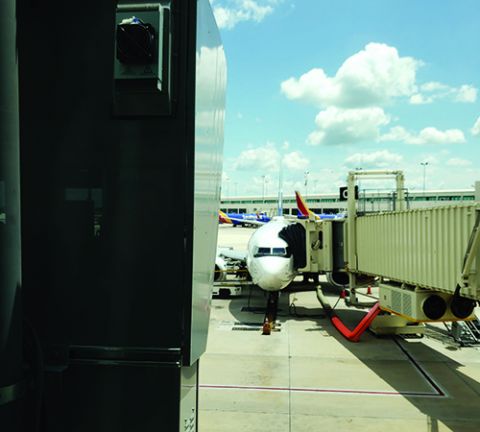Southwest Florida Int’l Counters Lightning Delays With Automated Docking Systems


Sandwiched between two large bodies of water, the peninsula of Florida receives lots of warm, humid air. When combined with sunlight and ocean breezes, it’s the perfect brew for thunderstorms—and operational challenges for airports like Southwest Florida International (RSW) in Fort Myers.
“Thunderstorms happen quite a lot in this part of the country,” says Al Gulamali, the airport’s director of operations and safety. “You can almost set your watch by it as the humidity builds.”
When lightning is raging, it’s simply too dangerous for ground crews to be on the tarmac guiding aircraft into gates. RSW recently installed an automated docking system on each of its concourses to mitigate such risks and keep planes moving.
|
Project: Automated Docking Systems Location: Southwest Florida Int’l Airport Gates Equipped: 3 (one in each concourse) Product: ADB SAFEGATE Safedock A-VDGS Design-Builder: Aero Group Designer: AERO Systems Engineering Builder: AERO BridgeWorks Installation: System installed on D concourse in Sept. 2018; B concourse in Jan. 2019; C concourse in May 2019 Implementation: Airport Terminal Services (ATS) Key Benefits: Enhanced safety during thunderstorms because marshaling crews can stay inside; improved gate efficiency & planning |
The seed was planted two years ago, when Jeff Mulder, RSW’s new executive director, saw a demonstration of an automated docking system at the annual conference for the American Association of Airport Executives. He gathered more information on the show floor and filed it away in his mind.
Six months later, Mulder looked out his office window during a typical summer storm and saw aircraft on the ramp waiting too long to be parked. “Arriving aircraft were pulling into the ramp but were holding out a couple of hundred feet,” explains Gulamali. “There was not any marshaling going on due to the lightning all over the place. It wasn’t safe for the ramp crew.”
The scene sparked Mulder’s memory about the trade show demo, and he picked up the phone…ultimately kicking off the process to issue a bid for a docking station to solve the problem.
After reviewing two responses to its request for proposals, the airport selected ADB SAFEGATE to install its Safedock advanced visual docking guidance system (A-VDGS) system for testing at D10, one of its common-use gates. RSW was already familiar with the company, as it has provided runway lighting and other systems to the airport for more than 20 years.
In order to use 2018 budget funds, RSW moved through the process quickly, and ADB SAFEGATE responded in kind. The company diverted a system from another project that had been delayed, and equipment was on site in 30 days.

Automated Docking Here & Abroad
The Safedock system uses cameras and lasers to provide precision guidance during irregular operations, notes ADB SAFEGATE Sales Manager Frederick Roe.
“Think about the camera on the back of your car. It requires contrast,” explains Roe. “Now imagine a white aircraft on a snowy or whiteout day. An absence of contrast is challenging for camera-only systems. That’s why we include cameras, but rely on the lasers for accuracy.”
During the docking process, lasers actively scan the gate area vertically and horizontally to capture and track aircraft. Scanning horizontally, the system measures parts of an approaching aircraft on either side of the centerline to determine the specific aircraft type and subtype. This ensures compatibility with the gate and also provides the flexibility to accommodate curved lead-in lines, multiple centerlines and challenging gate layouts, notes Roe.
 Automation facilitates safer operations by reducing the opportunity for human error, and speeds up the docking process, adds Gulamali. “In various kinds of weather, aircraft are parked faster, fuel burn and emissions are reduced, and ground crew are both safer and more efficient,” he elaborates. “As a result, the airlines can better deploy staff and plan more effectively.”
Automation facilitates safer operations by reducing the opportunity for human error, and speeds up the docking process, adds Gulamali. “In various kinds of weather, aircraft are parked faster, fuel burn and emissions are reduced, and ground crew are both safer and more efficient,” he elaborates. “As a result, the airlines can better deploy staff and plan more effectively.”
Roe notes that advanced visual docking guidance systems have been more widespread in Europe and other overseas markets because of the prevalence of common-use systems. Elsewhere in the world, ADB SAFEGATE often sells directly to airports, which then distribute the stations across their gates. In North America, the company sells to airports, airlines and facility operators.
Dallas Fort Worth International was one of the first U.S. airports to install the Safedock system back in 2008. Last year, Delta Air Lines ordered and installed 157 stations at Hartsfield-Jackson Atlanta International, the busiest passenger airport in the world. (A time-lapse video of the installation is available on YouTube.)

Installation
When RSW hired Aero Group to install its new docking stations, it did so under a separate contract from ADB SAFEGATE. Chris Britton, Eastern U.S. vice president of Aero Systems Engineering, notes that many airports prefer having a single point of contact, so one company is ultimately responsible. “It’s typically smoother for us to have a full design-build process,” he asserts.
In retrospect, Gulamali encourages other airports installing docking systems to use one contract vs. two, if possible.
After airport personnel received the A-VDGS equipment, they turned it over to Aero Group. The next step was reviewing the layout and determining the best point of attachment to the structure of the terminal building, explains Jason Pearson, a project executive at Aero BridgeWorks. To minimize the impact on airport operations, the company completed as much work as possible before the onsite installation.
 Typically, the operator/control panel is installed at the wheel of boarding bridges for easy access, but RSW went one step further. “Most docking systems have one control panel on the apron. But to better use it during lightning storms, we installed a second control panel inside the jet bridge so aircraft can be parked without anyone being outside,” explains James Hess, the airport’s airside operations manager. Gate agents simply walk down the inside of the boarding bridge to enter the relevant information about the aircraft without endangering themselves or anyone else, he comments.
Typically, the operator/control panel is installed at the wheel of boarding bridges for easy access, but RSW went one step further. “Most docking systems have one control panel on the apron. But to better use it during lightning storms, we installed a second control panel inside the jet bridge so aircraft can be parked without anyone being outside,” explains James Hess, the airport’s airside operations manager. Gate agents simply walk down the inside of the boarding bridge to enter the relevant information about the aircraft without endangering themselves or anyone else, he comments.
A change in plans about which gate would serve as the test site at RSW required quick adjustment by Aero Group personnel, who had already fabricated a bracket for the specific dimensions of another gate.
“It turned into a quick scramble to make sure we had the right mounting,” recalls Britton. “Typically, it takes two days to complete this kind of project. We have to terminate power, mount the bracket, hang the unit and then terminate the cabling to the unit and operator panel. Even with the gate switch, we were able to perform a two-and-a-half day installation.”

Aero Group started with the aircraft layout and gate arrangements. The team considered the height of the aircraft that typically park at that gate to configure it properly.
“We did a similar project in Atlanta,” says Britton. “We had multiple-height parking at one gate, and it was a challenge to accommodate them all.”
Once the unit is mounted, ADB SAFEGATE calibrates it to that specific location. If the system is moved, a technician may have to recalibrate it and define the field of view for the equipment and striping elements—a process that takes a few hours. “Basically, you’re defining the containment zone,” explains Britton.
Ideally, the docking station is mounted on a building, he adds. “Sometimes, we can’t get away from locating the system on a pole mount; but it’s always better to keep the units off the ramp if possible.”

Mounting the system on a pole sometimes requires reconstruction of the apron area, which adds time and cost. “You could go from a simple installation to adding a pole, running fiber, dealing with concrete and rebar and so on,” Pearson says.
“Not all installation locations are the same,” adds Rob Brethaur, vice president of business development at AERO Group. “For example…this particular south Florida location required more complex structural engineering design to ensure that the system could withstand hurricane force winds.”
Integration
As the ground handler for several airlines at RSW, Airport Terminal Services (ATS) trains its staff on how to use the aircraft docking system. The company also provides baggage delivery and aircraft cleaning services at the airport.

ATS Ramp Manager Frank Pinho reports that ground crews and pilots appreciate RSW’s new docking system. “They’d rather work with electronic guidance because it’s nearly foolproof,” says Pinho.
Hess emphasizes that the Safedock system is not complicated to operate. Gulamali and his team use a walking test, which allows ground crew to make sure the station is working properly by literally “standing in” for a plane.
“The computer control panel guides you through it very easily,” he says. “Once you train someone how to use it, it’s simple to pick up.”
Carrier Challenges
While pilots across the board are reportedly thrilled about the docking stations, some airlines have been slower to approve them than the airport had hoped. For Gulamali, the system’s benefits are clear, and he predicts that airlines currently unsure of the technology will quickly recognize its advantages. Getting passengers off planes during storms has a huge impact on passenger satisfaction, he notes.
There are also benefits to be had during good weather—for carriers and the airport. “Let’s say an airline has arrivals coming in within two minutes of each other but only has one ground crew,” explains Hess. “They could use the docking station on one gate and the ground crew on the other. It helps with resources and improves customer service. Then, passengers can de-board the aircraft, use the restrooms, stretch their legs, purchase concessions and so on.”
More Automation Anticipated
RSW’s first docking station was installed on gate D10, which is used by JetBlue, American Airlines and Spirit. After it proved successful, airport officials decided to install two more units, so each concourse would have one. Gate C1 was chosen because United and WestJet usually share it. On the international concourse, a station was installed at B3, mainly for Air Canada, Frontier, EuroWings and Southwest.

Gulamali reports that the docking systems get quite a bit of use—especially in Concourse C.
“It’s only a matter of time before more airlines will secure approval to use it,” he predicts. “Pilots are keen to dock at an automated gate because many of them have used them before.”
“Every airport wants to improve safety and efficiency on the ramp,” adds Roe. “In the case of lightning, having aircraft parked at the gate and not idling is useful for airports and airlines. As a passenger, think about every time you hear ‘We’re just waiting for a crew to dock us,’ and imagine what it would be like to avoid that. We see significant gains for airports that experience a lot of lightning; but airports using this see gains across the board.”
FREE Whitepaper
PAVIX: Proven Winner for All Airport Concrete Infrastructure
International Chem-Crete Corporation (ICC) manufactures and sells PAVIX, a unique line of crystalline waterproofing products that penetrate into the surface of cured concrete to fill and seal pores and capillary voids, creating a long lasting protective zone within the concrete substrate.
Once concrete is treated, water is prevented from penetrating through this protective zone and causing associated damage, such as freeze-thaw cracking, reinforcing steel corrosion, chloride ion penetration, and ASR related cracking.
This white paper discusses how the PAVIX CCC100 technology works and its applications.
 facts&figures
facts&figures








